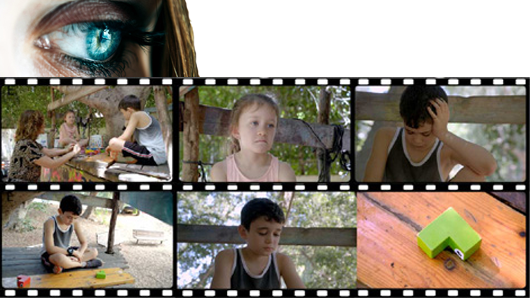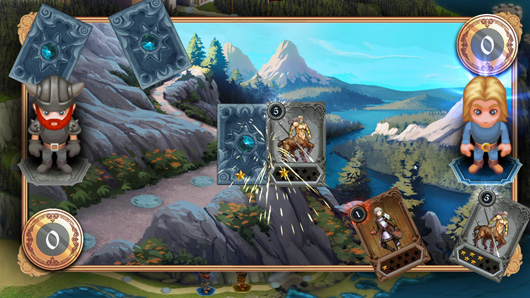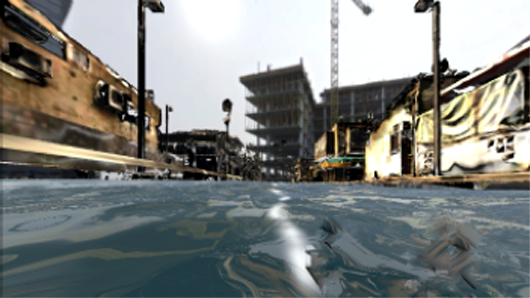Research Projects
The
Neuroscience of Point-of-View Editing
and Cinematic Engagement
 Point-of-view
editing, which makes a character's perceptual flow visible, is a
unique cinematic device. As point-of-view editing aligns the spectator
with a character's perception in a way that was not possible before
cinema, several film scholars have argued that this technique boosts
empathy and identification. Other researchers, however, have cast
doubt on this notion, pointing to the lack of supporting evidence.
This project employs a set of psychophysiological tools, including
fMRI and eye-tracking, to investigate the effect of point-of-view
editing on the spectator engagement with cinematic characters. Our
interdisciplinary team scripted, shot, and edited short narrative
movies that manipulate point-of-view editing and integrate them into
an experimental protocol that examines the behavioral and neural
effects of this special cinematic technique.
Point-of-view
editing, which makes a character's perceptual flow visible, is a
unique cinematic device. As point-of-view editing aligns the spectator
with a character's perception in a way that was not possible before
cinema, several film scholars have argued that this technique boosts
empathy and identification. Other researchers, however, have cast
doubt on this notion, pointing to the lack of supporting evidence.
This project employs a set of psychophysiological tools, including
fMRI and eye-tracking, to investigate the effect of point-of-view
editing on the spectator engagement with cinematic characters. Our
interdisciplinary team scripted, shot, and edited short narrative
movies that manipulate point-of-view editing and integrate them into
an experimental protocol that examines the behavioral and neural
effects of this special cinematic technique. Partners: Prof. Dov Rubinstein, Prof Liad Mudrik, Prof. Tim Smith, and Dr. Jonathan Frome. The project is supported by Israel Science Foundation.
XTics
- A Gamified Tool for Intervention in Tic Disorders
 Tics are involuntary motor and/or vocal behaviors, which affect about
3% of the children. While they are rarely dangerous, tic disorders
commonly involve significant psychological distress for children who
manifest them as they cause social problems in family and school
environment. Existing behavioral treatments in tic disorders are
considerably successful, but their effectiveness is compromised by
limited access due to a shortage in expert clinicians. Moreover,
behavioral therapies in tic disorders are also limited by the reduced
compliance of young patients with the demanding training protocols.
Tics are involuntary motor and/or vocal behaviors, which affect about
3% of the children. While they are rarely dangerous, tic disorders
commonly involve significant psychological distress for children who
manifest them as they cause social problems in family and school
environment. Existing behavioral treatments in tic disorders are
considerably successful, but their effectiveness is compromised by
limited access due to a shortage in expert clinicians. Moreover,
behavioral therapies in tic disorders are also limited by the reduced
compliance of young patients with the demanding training protocols. We have developed a video game, informed by neuroscience, to serve as an intervention tool for tic disorders, where abnormalities in dopamine have been identified as a significant factor. In our initial study, we demonstrated that certain elements, which were integrated into the game to induce phasic dopaminergic responses, indeed escalate the frequency of tics. In a subsequent study, we developed a protocol for exposure and response prevention where the game triggers tics, and the users' progress is influenced by their ability to manage them. We discovered that this gamified protocol not only fosters significant engagement with the treatment but also demonstrates sustained clinical effectiveness.
Partners: Prof. Yael Leitner, Dr. Michael Rotstein, and Dr. Tamar Steinberg. The project is supported by the BrainBoost Innovation Center of the Sagol School of Neuroscience at Tel-Aviv University, and by the Tourette Association of America.
Gamified
Virtual Reality Interfaces for Motor Learning
and Rehabilitation
 Cerebral Palsy (CP) is the most common childhood physical disability.
Unilateral spastic CP accounts for 36.4% of these children causing
hemiparesis, where one side of the body is more affected and
functionally-impaired than the other. Current evidence-based practice
includes constraint-induced movement therapy (CIMT) as a
moderate-to-strong recommended intervention for children with CP. This
therapy, which constrains the less-affected limb to improve the use of
the hemiparetic arm, increases function through motor learning.
However, compliance with CIMT is significantly compromised due to
technical inconvenience and the intensity of the practice.
Cerebral Palsy (CP) is the most common childhood physical disability.
Unilateral spastic CP accounts for 36.4% of these children causing
hemiparesis, where one side of the body is more affected and
functionally-impaired than the other. Current evidence-based practice
includes constraint-induced movement therapy (CIMT) as a
moderate-to-strong recommended intervention for children with CP. This
therapy, which constrains the less-affected limb to improve the use of
the hemiparetic arm, increases function through motor learning.
However, compliance with CIMT is significantly compromised due to
technical inconvenience and the intensity of the practice.Our project introduces a pioneering immersive CIMT-VR application. In this application, the user takes on the role of a virtual avatar in a manner that significantly enhances the motor improvement of the affected arm and restricts the less-affected arm without the need for external instruments. We utilize specific gamified reinforcement mechanics to facilitate alteration of the body schema. This contributes to the creation of an engaging and personalized VR intervention designed specifically for children with Cerebral Palsy (CP).
Partners: Dr. Alexis Mitelpunkt, Director of Pediatric Rehabilitation at Dana Children’s Hospital, Tel Aviv Medical Center, and Prof. Sigal Portnoy from the Department of Occupational Therapy, Tel-Aviv University.
Embodied
Memories from a Burning Future
 Climate change is already affecting us, and it is unfolding as an
existential crisis. In order to grasp the severe consequences of
climate change as an urgent event and react to this threat
effectively, perceiving climate change as a crisis that will effect us
personally is vital. Unfortunately, the human mind is poorly designed
for this task. As explained by the Construal Level Theory (CLT) of
Psychological Distance (Trope and Liberman 2008), as objects or events
are more psychologically distant, they will be represented at a more
abstract, higher level of construal, which is perceived as more
improbable. For many, climate change is still considered to be a
problem that belongs to someone else, far away, or in the future,
psychologically distant from ourselves. Therefore, although climate
change is a real threat to our future, we are not doing enough in
order to mitigate the causes of climate change, such as the
emission
of CO2
and other greenhouse gases.
Climate change is already affecting us, and it is unfolding as an
existential crisis. In order to grasp the severe consequences of
climate change as an urgent event and react to this threat
effectively, perceiving climate change as a crisis that will effect us
personally is vital. Unfortunately, the human mind is poorly designed
for this task. As explained by the Construal Level Theory (CLT) of
Psychological Distance (Trope and Liberman 2008), as objects or events
are more psychologically distant, they will be represented at a more
abstract, higher level of construal, which is perceived as more
improbable. For many, climate change is still considered to be a
problem that belongs to someone else, far away, or in the future,
psychologically distant from ourselves. Therefore, although climate
change is a real threat to our future, we are not doing enough in
order to mitigate the causes of climate change, such as the
emission
of CO2
and other greenhouse gases.Is it possible to make climate change feel like our problem; to feel that it is happening to us, to our body, here and now? Our project offers a new approach for tackling this psychological barrier. Using immersive VR, in which participants are present in the climate change scene while embodied in their own realistic body, we simulate the effect of an actual climate change event as close as possible to the physical reality, by creating embodied memories from the future climate. The project examines the potential of this approach to shorten the psychological distance, and change perceptions, attitudes and behavior intentions in relation to climate change.
Partners: Prof. Nurit Carmi, Dr. Maya Negev, and the Porter School of Environmental Studies (image: Scan the City Studio).
Augmented
Reality Storytelling in Parkinson's Disease Characterization
 Up to 60% of Parkinson's disease patients will experience Freezing of
Gait (FOG) during the disease. FOG is a sudden and brief episode of
inability to progress forward despite the willing to walk. It is a
major cause of falls in Parkinson's patients, injures and even death.
However, diagnostic methods today are general, and it is difficult to
understand the specific cause of FOG in each patient. In this project
we employ augmented reality technology and experiment with its unique
storytelling techniques. We aim to find the specific trigger for each
patient, including stress and cognitive load, in order to provide the
best treatment for each patient individually.
Up to 60% of Parkinson's disease patients will experience Freezing of
Gait (FOG) during the disease. FOG is a sudden and brief episode of
inability to progress forward despite the willing to walk. It is a
major cause of falls in Parkinson's patients, injures and even death.
However, diagnostic methods today are general, and it is difficult to
understand the specific cause of FOG in each patient. In this project
we employ augmented reality technology and experiment with its unique
storytelling techniques. We aim to find the specific trigger for each
patient, including stress and cognitive load, in order to provide the
best treatment for each patient individually. Partner: Prof. Anat Mirelman.